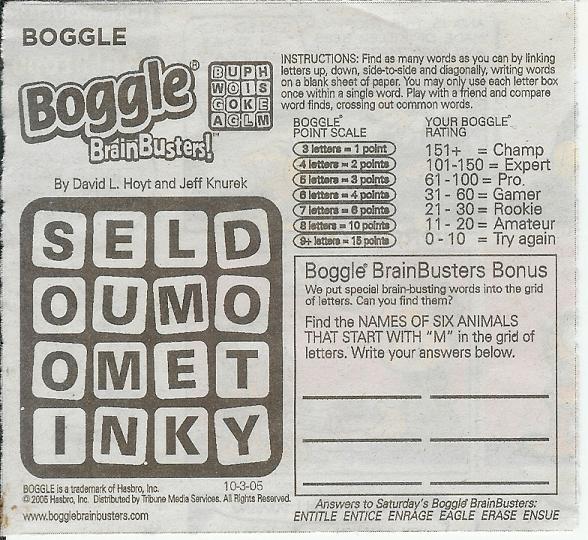
Write a program to solve Boggle, a popular board game. Each day, the Miami Herald has a Boggle game. In boggle, you form words by using adjacent characters. You may not reuse a character in a given position to form a word, though repeated characters in different positions can be used. A recent Boggle game is shown below. It contains such words as memo, monkey, mule, and mouse

The puzzle file is a two dimensional array of characters.
The dictionary of valid words is dict.txt, with the usual disclaimer that it is not my dictionary and may have some inappropriate words. It is too large to manually screen.
Your output should list each word found, along with the number of points it is worth (see the image above), the location where the characters in the word can be found, and the total number of points. If the number of words exceeds 200, you don't have to print them all out. Instead, print out only the words of length eight or more, and a summary of how many words of each length 3-7 there are (and the number of points they account for).
Next, the basic recursive login would be something along the lines of the following (note you should use fully typed collections, such as Map<String,List<Position>>):
/**
* Routine to solve the Boggle game.
* @return a Map containing the strings as keys, and the positions used
* to form the string (as a List) as values
*/
public Map solveBoggle( )
{
Map results = new HashMap( );
List path = new ArrayList( );
for( int r = 0; r < rows; r++ )
for( int c = 0; c < columns; c++ )
{
solve( newPosition( r, c ), "", path, results );
}
return results;
}
Observe that solveBoggle calls the routine solve for
each position in the grid. solve is recursive,
and implementing it is virtually the entire assignment.
After you implement solve you should have a routine
that can print out, in a nice form, the Map returned
by solveBoggle, to meet the output specifications above.
The specification for the recursive solve routine is:
/**
* Hidden recursive routine.
* @param thisPos the current position
* @param charSequence the characters in the potential matching string thusfar
* @param path the List of positions used to form the potential matching string thusfar
* @param results the Map that contains the strings that have been found as keys
* and the positions used to form the string (as a List) as values.
*/
private void solve( Position thisPos, String charSequence, List path, Map results )
{
/* Less than one page of code will do it. */
}
In implementing solve you will want to do the following: